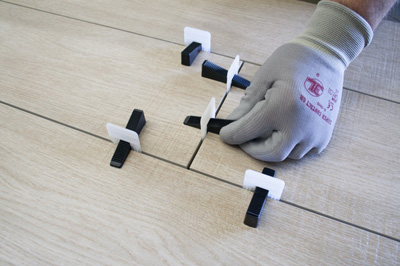ATTENTION
Carefully follow these instructions to ensure correct installation.
- Installation should be carried out by a qualified professional.
- Before installing ensure that the material is in perfect condition. Make sure you check the colours, finishes and thicknesses because DUNE will not accept any claims or returns of material after it has been installed.
- Before each stage, on one part test all of the materials and tools to be used and evaluate the final finish of the test. Should you fail to achieve the desired results do not continue with the installation, and consult our sales team.
- In public places materials must comply with the slipperiness requirements of the Spanish Technical Building Code.
- This document is purely commercial and may not be used in any legal or administrative proceedings, neither as an expert opinion nor as documentary evidence, unless expressly authorized by DUNE CERÁMICA S.L.
1. PROPER PREPARATION OF SURFACE
The wall must be firm, levelled, dry and clean. Uneven surfaces greater than 2 mm must be levelled with specific products. All cracks and imperfections should be repaired, so that the wall is completely smooth. The moisture content of the surface must be under 2%.
2. INSTALLATION MATERIAL
For a correct installation, several factors must be taken into account: Material kind of the wall to be tiled (synthetic pannels, plaster, wood, etc.), wall stability, environmental conditions, kind of surface to be covered , speed of carrying the work, etc. All the above parameters determine the choice of the adhesive kind.
All the adhesive materials recommended by DUNE have been previously tested in our facilities, in controlled environmental conditions and on rigid brick and/or concrete walls. Under different conditions from the above mentioned, it is recommended to test firstly and if in doubt, please contact DUNE or the adhesive distributor.
White and Red body wall tile: C1 concrete glue. (Consult adhesives table).
Stoneware and porcelain tile: C2 concrete glue. (Consult adhesives table).
DUNE always recommends to test first the material with minimum two pieces before placing all the material.
3. INSTALLATION
We recommend starting the installation from the floor to the ceiling, continue in phase to allow the adhesive the necessary time to get dry. Extend a thin layer of adhesive on to the surface where the piece will be installed (3mm approx.) Then, use a notched trowel no. 3 to make incisions into the adhesive layer. Place the piece while the adhesive is still soft and before a dry layer of film forms on the adhesive surface. To install 30×60 pieces or similar, extend a thin layer of adhesive on the surface where the piece will be installed (vertically) and another layer on the back of the piece itself, in the opposite sense (horizontally). Then, use also a notched trowel no. 3 and make the incisions into both the adhesive layer of the wall and in the opposite sense in the piece. Do not use dot setting or dab the adhesive during installation.
Once the piece is placed, press carefully to obtain correct adhesion and cover possible areas without adhesive. For a better fixing, it is recommended to set the pieces by using some tape or a wooden strip. To correct the position of the bases, it is recommended to take them off and correctly clean their back part before placing them again.
We recommend a minimum joint of 2mm and the use of crosspieces. For areas with severe thermal dilatation or non-stable surfaces (plasterboard), a minimum joint of 3 mm is strongly recommended.
DUNE recommends the use of SELF-LEVELING SPACERS to avoid the appearance of lippage between adjacent pieces.
The placement of a locked joint greater than 25% is not recommended to avoid the appearance of uneven or lippage between adjacent pieces. Claims of material placed on a locked joint greater than 25% will not be accepted.
Models manufactured with LUX resin components should not be installed in areas close to a heat source, such as behind radiators, in saunas, near burners, etc.
4. GROUTING
All joints must be perfectly clean and dry and having a minimum depth of 2mm. Use a flat rubber trowel to spread the paste, being sure that the joints are completely covered. Use a wet sponge or neutral PH products – never abrasive products – to wash off immediately the excess of grouting paste from the surface before it dries.
It is very important to do this before the paste dries. If this happens, use a cement remover to clean the surface
For better waterproofing, it is necessary an epoxy grouting paste, especially in water areas
Items decorated by pre-cuts, so that it is recommended to follow the lines of those pre-cuts in order to get a correct finish. Make sure that the distance between one sheet and another is the same as the one of pre-cuts, so that all the joints look alike. It is not necessary to use crosspieces as the pre-cuts can be used as joining references.
Consult the grouting materials table.
Important:The colour of the grouting paste might change the product’s appearance. We recommend to test with some pieces before grouting the entire surface.
5. CLEANING AND MAINTENANCE
For everyday cleaning, use regular cleaners with PH neutral. Do not use abrasive products.
PVD AND DELICATED PRODUCTS: Avoid using abrasive and anti-lime cleaners or steel wool. Preferably use pH neutral cleaning products.















